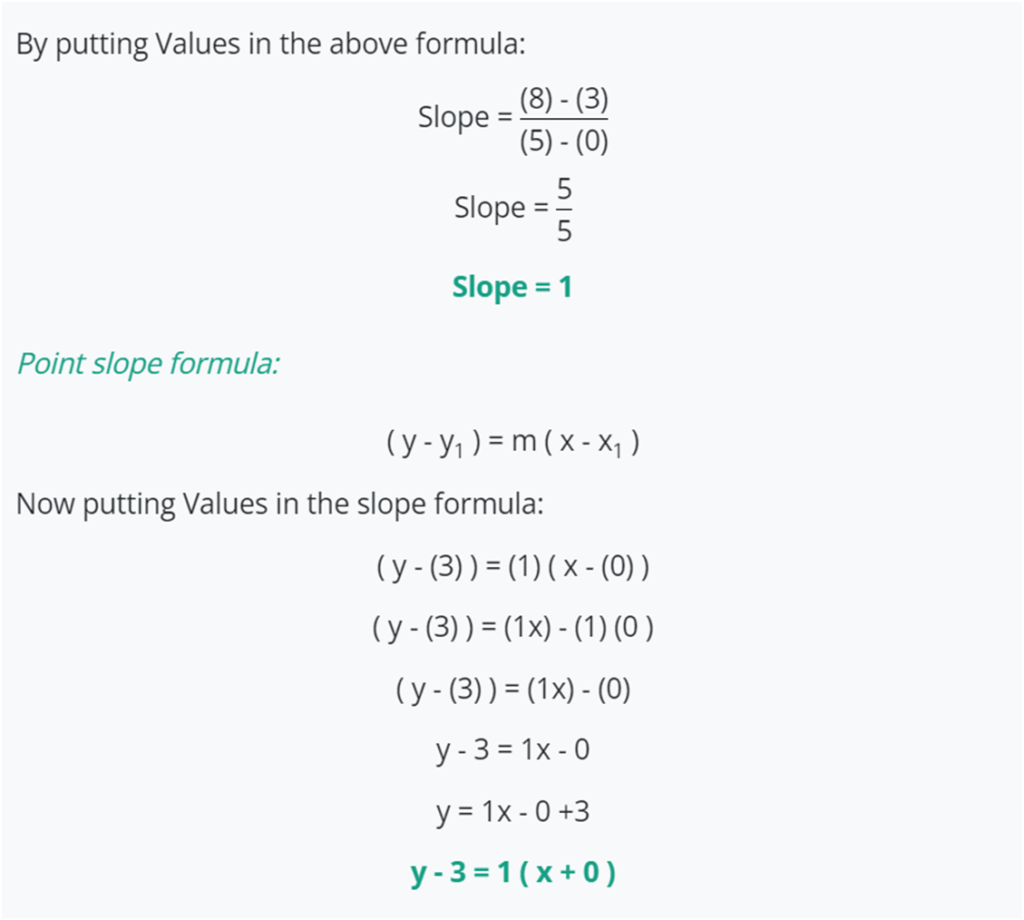Introduction to Point Slope Form: Explanation & Calculations
The point-slope form (or point-gradient form) is a method of writing the equation of a straight line in a two-dimensional Cartesian coordinate system. This form acts as the standard form for a linear equation. A linear equation has unknown variables whose degree (or power) is one. The straight-line equation can be determined through the following techniques.
- Point-slope form
- Intercept form
- Slope-intercept form
- Two-point form
We will confine ourselves to only the point-slope form in this article. It is used when the value ofthe slope and point on the line are known. Then by this, we understand the concept of the point-slope form and explain the step-by-step solution by deriving its formula in the upcoming section.
What is the Point-Slope Form?
The point-slope form is used in algebra to represent linear equations with the help of two variables. This technique comes from the slope formula. Point slope form helps to calculate the equation of a line when a single point and the slope of a line are given. This approach offers greater flexibility in writing equations for straight lines than other methods.
The general form of the point-slope mathematically is written as.
y – y₁ = m(x – x₁)
Formula of Point Slope Form
The point-slope formula is a method of expressing the equation of a straight line in mathematics. The formula is usually written as:
y – y₁ = m(x – x₁)
Here;
- m expresses the incline or steepness of the line.
- (x, y)is any random point on a straight line.
- x₁ and y₁ represent the coordinates of a specific point through which the line passes.
Derivation of the Point-Slope equation
Let us learn how to derive the formula of point slope form by using the concept of slope.
The slope of a line is defined as the variation in the y-coordinate divided by the change in the x-coordinate.
∴ m = (y – y₁) / (x – x₁)
Perform multiplication on both sides with (x – x1)
m(x – x₁) = (y – y₁)
or(y – y₁) = m(x – x₁)
That is the standard form of a point-slope equation.
Converting between Point Slope and Slope-Intercept Form
Converting between Point Slope Form and Slope-Intercept Form is straightforward.
Start with the standard form of point-slope.
(y – y1) =m (x -x1)
Expand the right side.
y – y1 =mx -mx1
Isolate y on the left side by adding y1 to both sides.
y =mx -mx1 + y1
That is slope-intercept form.m is the slope, and -mx1 + y1 is the y-intercept b. So the equation will become
y =mx + (-mx1 + y1)
Advantage of Point Slope Form
Problem-Solving: It simplifies real-world problem-solving when working with linear relationships.
Precision: It allows for precisely representing a line through a single point and its slope.
Flexibility: This form enables easy transition between different linear equations.
Steps to Solve Point Slope Form
- Identify the coordinates of a point on the line (x1, y1) and the slope m.
- Put the given values into the equation of point-slope.
- Distribute the slope and points in the equation to simplify it further.
- That is the point-slope equation. This linear equation describes the interrelation between the variables.
Solved Examples of Point Slope Form
Let’s solve some examples to find an equation of a line with the help of point slope form.
Example 1:
Evaluate the equation of the straight line that passes from the points (2, 4) and has a slope of -2.
Solution:
Slope m = -2
(x1, y1) =(2, 4)
The standard equation of point slope is written as.
y – y1 = m(x – x1)
Plug the given values in the formula.
(y – 4) = (-2) (x – 2)
y – 4 = – 2x + 4
– 2x + 4 – y + 4 = 0
2x + y – 8 = 0
The equation of the line “2x + y – 8 = 0” passes through the points (2, 4) and with the slope of “-2”.
Example 2:
Find the straight-line equation that passes from the points (0, 3) and (5, 8) in point-slope form.
Solution:
Given Data:
(x1, y1) = (0, +3)
And (x2, y2) = (5, 8)
Step 1: The slope of the line going through (0, 3) and (5, 8) is.
⇒m = (y2 – y1) / (x2 – x1)
⇒ (8 -3) / (5 – 0)
= 5 / 5= 1
Step 2: The equation represents the line that passes through the point (5, 8) under the slope of 1 can be represented as below.
y – 8 = (1) (x – 5)
y – 8 = x – 5
x – y + 3 = 0
Step 3: The equation of a line with a slope of 1 and pass from the point (0, +3) can be written as.
(y – 3) = 1(x – 0)
The equation of a line that passes through the points (0, 3) and (5, 8) is (y – 3) = 1(x – 0).
You can also use a point slope formula calculator to find the equation of the line according to the general equation of point slope form.

Conclusion
We discussed the concept of the point-slope form to represent the linear equation by the two variables. We examined its derivation and the steps to solve this form. We discussed the conversion between point-slope and slope-intercept forms and highlighted its advantages that describe its importance.
We have also provided some solved examples to illustrate its application. Overall, the point-slope form is a valuable tool in algebra for describing linear relationships with clarity and simplicity.
-
Jameshttps://www.ijltemas.in/blogs/author/ijltemasadmin/
-
Jameshttps://www.ijltemas.in/blogs/author/ijltemasadmin/
-
Jameshttps://www.ijltemas.in/blogs/author/ijltemasadmin/
-
Jameshttps://www.ijltemas.in/blogs/author/ijltemasadmin/
